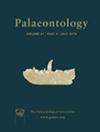用NaOH溶液从燧石中提取牙形石和放射虫的新方法
IF 2.3
2区 地球科学
Q1 PALEONTOLOGY
引用次数: 0
摘要
微体化石是沉积岩的重要组成部分,用于古生物学、生物地层学、古环境和古气候研究。它们通常使用酸溶液从岩石中提取,酸溶液可能因嵌入岩石的岩性而异。在这里,我们提出了一种使用普通NaOH(氢氧化钠;苏打)消化燧石(微晶石英和隐晶质石英)的新方法,而不是基于HF(氢氟酸)的标准技术。这种新方法可以收集不同类型微体化石的未损坏标本,如牙形石、放射虫、牙齿和真皮鳞片,其矿物学仍在保存(例如牙形石中的生物磷灰石)。因此,建议使用苏打水,因为它危险性较小,价格较低,而且在形状和矿物学上都能更好地保存提取的微体化石。本文章由计算机程序翻译,如有差异,请以英文原文为准。
A new method for extracting conodonts and radiolarians from chert with NaOH solution
Microfossils are important components of sedimentary rocks used for palaeontological, biostratigraphic, palaeoenvironmental and palaeoclimatic investigations. They are usually extracted from rocks using an acid solution, which might vary depending on the embedding rock lithology. Here we propose a new method using common NaOH (sodium hydroxide; soda) to digest cherts (micro‐ and cryptocrystalline quartz) instead of the standard technique based on HF (hydrofluoric acid). This new method allows the collection of undamaged specimens of different kinds of microfossils, such as conodonts, radiolarians, teeth and dermal scales, the minerology of which is still preserved (e.g. biogenic apatite in conodonts). The use of soda is thus recommended, as it is less dangerous, less expensive, and it better preserves the extracted microfossils both in shape and mineralogy.
求助全文
通过发布文献求助,成功后即可免费获取论文全文。
去求助
来源期刊

Palaeontology
地学-古生物学
CiteScore
5.60
自引率
3.80%
发文量
43
审稿时长
6 months
期刊介绍:
Palaeontology publishes a wide variety of papers on palaeontological topics covering:
palaeozoology
palaeobotany
systematic studies
palaeoecology
micropalaeontology
palaeobiogeography
functional morphology
stratigraphy
taxonomy
taphonomy
palaeoenvironmental reconstruction
palaeoclimate analysis and biomineralization studies.
 求助内容:
求助内容: 应助结果提醒方式:
应助结果提醒方式:


